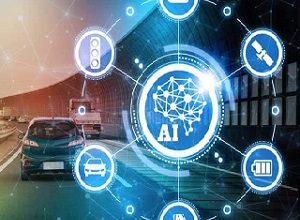Connected vehicles: Key to all our road transportation problems!

Connected Vehicles
Your car not only communicates with you but also with the car in front of you, the traffic sign on the side of the road, and also to those traffic lights you see ahead. The advancements in the field of the automotive industry have led to the development of connected vehicles (CV) and their data platforms. The CV paradigm dictates that all advanced vehicles be equipped with technology that allows them to communicate with nearby vehicles, connected infrastructure, and surroundings.
CVs are architected in a framework that works well for both short-range communication (DSRC) and long-range communication. This form of communication has an array of applications, as it can support a whole new generation of in-fleet safety features. In fact, vehicle connectivity can assist drivers to prevent 76% of crashes on the road—greatly reducing the cost of accidents and fatalities.
How did they come to be?
The need to access better information created a demand for smarter infrastructure and technology. Increasing demand for “always connected” has opened up a market for CVs and their data platforms across the world. The wide umbrella of connectivity is allowing fleet managers to share information seamlessly. CVs really bring the best of both worlds–the collection of sensor data in real-time and its secure transmission. The concept of CVs is appealing because anyone can access the right information at the right time. CVs can ensure smooth integration between your smartphones and your fleets. The minimal power requirements, the affordable cost to consumers, and the easy-to-scale model of connected vehicles are gaining traction among fleet businesses. Therefore, the potential of CV is really promising.
Why do they matter?
V-2-X (Vehicle to everything) connectivity has always been all about providing users with better data and analytics. Connected vehicles communicate in a framework that allows real-time, short-range, over-the-air data exchange. This manner of communication allows vehicles to detect potential hazards, calculate risks, and issue warnings. With such vehicle connectivity, your fleet will always have 360-degree awareness of their position in relation to the other vehicles. Besides, connectivity improves drivers’ judgment and helps them make better on-road decisions.
Connected vehicles create new, data-rich environments and are vital in attaining less congested and more eco-friendly roads. In fact, connected vehicle technology aims to tackle some of the biggest challenges of the transportation industry:
- Safety:
According to WHO statistics, every 24 seconds, a fatal, life-threatening accident occurs around the world. Even with the presence of safety features like airbags and antilock brakes, the number of traffic fatalities continues to rise. Road accidents not only hurt lives but also create economic strain. In the United States of America alone, the annual cost of vehicle breakdown amounts to almost 227 billion dollars. The cost of accidents affects businesses in more ways than one, which is why there is a dire need for solutions. Accidents mean repair expenses, driver injuries, lower productivity, and higher insurance premiums. All these combined can really dent your ROIs and affect your business adversely.
To tackle all these issues, CVs will give drivers the tools they need to anticipate collisions and reduce the number of casualties. With safer drivers, we’ll have safer roads. Hence, these CVs are equipped with features that help drivers prioritize safety. For instance, with CV platforms, your car (and drivers) can communicate with the car in front of it. If you (or your drivers) are tailgating or driving at such speeds that collision is guaranteed, you will get notified and will be required to slow down. Such a mechanism greatly reduces the risk of rear-ended collisions. Additionally, alerts and warnings for reckless driving, traffic violations, or frequent lane departures can be issued as well. Thus, the CV platform helps drivers execute compliance on the road by providing tools to enhance holistic safety.
- Mobility:
Nobody likes traffic! Owing to rapid urbanization and population boom, today’s roads have been more congested than ever. In fact, in a year, the people of Mumbai, India spend 11 days in traffic while commuting. According to the findings of the Central Road Research Institute (CRRI), the fleets of Delhi waste 40,000 liters of fuel per day in traffic.
The effects of such congestion on everyday productivity, fuel consumption, and sustainability are devastating. In this context, vehicle connectivity is seen as a valuable tool, almost a coping mechanism of sorts, to deal with the exponentially rising commute times and carbon emissions. Connected vehicles can keep the traffic moving and here’s how:
V-2-X communication will generate an incredible amount of new data about how, when, and where vehicles travel. Such big data, when incorporated with predictive AI technology, can help fleet managers identify the best times to dispatch their vehicles. This wave of data will give birth to multiple transport applications that can help people with their traffic experience.
- Environment:
Vehicles consume a lot of energy even before they start running on the road. The manufacturing process itself takes a great toll on the environment. When on the road, these vehicles consume petroleum products like petrol and diesel. Extraction, distillation, and combustion of petrol is an energy-intensive process. The transportation sector alone contributes 27% of the global carbon-dioxide emissions. Such exhaust leaves a devastating carbon footprint and contributes significantly to global warming. Besides that, fuel costs are one of the biggest expenses for a fleet manager. Therefore, monitoring your fuel consumption and expenses is crucial.
Here, connected vehicle data platforms can be of great help. They will generate data that can help drivers make smarter, greener transportation choices. For example, with access to real-time information about traffic conditions, drivers can choose alternative routes. Data platforms can help fleet managers achieve fuel efficiency through route optimization. Unnecessary stops at intersections, stop signs, and roundabouts can be eliminated through short-range communication. A longer range of communication established via GPS platforms can help fleet managers get insights into fuel and driver costs. They can leverage such data to streamline their fuel/energy use.
Conclusion:
The pace at which technological developments are taking place in the automotive industry has sped up in recent years. Vehicle connectivity is one of those advancements that brings along with it some pragmatic challenges. On the bright side, they have opened up a whole new world of possibilities and applications. From traffic management to in-fleet driver coaching, from keyless fleets to real-time data analytics—anything and everything is possible with CVs. The importance of such technologies can never be undermined. CVs provide a platform to put data to good use and make roads safer, more efficient, and more economical than ever before.
References:
https://www.ncbi.nlm.nih.gov/pmc/articles/PMC8622391/#sec3-sensors-21-07712title
https://www.its.dot.gov/factsheets/pdf/connected_vehicles_work.pdf
https://citeseerx.ist.psu.edu/viewdoc/download?doi=10.1.1.441.7658&rep=rep1&type=pdf
Author:

Tushar Bhagat
Director
Uffizio India Pvt. Ltd.
Tushar Bhagat is the CEO of Uffizio. He has simmered 15 years worth of informatics knowledge & experience into a one-of-a-kind telematics platform. This fleet management system has been acclaimed and widely used by businesses in over 60 countries. Mr. Bhagat firmly believes in finding creative solutions to everyday challenges—so businesses can bloom into their full potential.
Published in Telematics Wire

